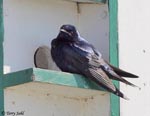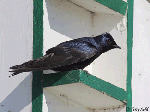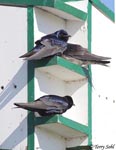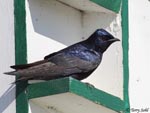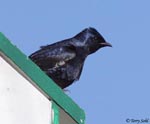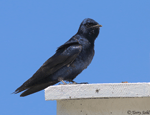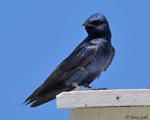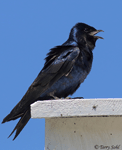| Length: 8 inches | Wingspan: 16 inches | Seasonality: Summer |
| ID Keys: Forked tail, pointed wings, iridescent dark purple body (male) | ||
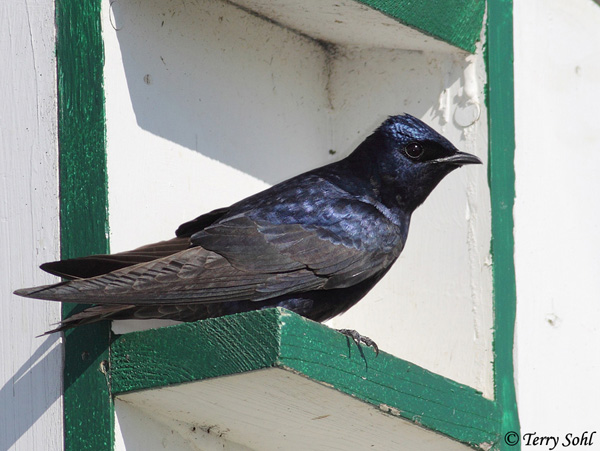 Purple Martins are one of
the home-birders' favorites, with the multi-cavity Purple Martin house a
familiar sight in residential areas throughout the eastern half of the United
States. As natural nest sites have become more rare, most Purple Martins now
nest in these artificial sites. The practice of attracting Purple Martins
through the placement of artificial nest sites has its roots with Native
American tribes, who once attracted the birds by placing gourd homes near tribal
communities. Placing nest boxes has a history in the eastern US
going back to at least the early 1800s.
Purple Martins are one of
the home-birders' favorites, with the multi-cavity Purple Martin house a
familiar sight in residential areas throughout the eastern half of the United
States. As natural nest sites have become more rare, most Purple Martins now
nest in these artificial sites. The practice of attracting Purple Martins
through the placement of artificial nest sites has its roots with Native
American tribes, who once attracted the birds by placing gourd homes near tribal
communities. Placing nest boxes has a history in the eastern US
going back to at least the early 1800s.
Habitat:
Can be found in a wide-variety of semi-open habitats, as long as adequate nest sites are available. Traditionally, nesting sites were along riparian areas or woodland edges, where tree cavities were available and adjacent to open foraging sites. With the widespread use of nesting boxes, Purple Martins are now often found in suburban areas, although they still require large open spaces for foraging.
Diet:
Exclusively insects. Primarily flying insects, but occasionally spiders and other insects as well.
Behavior:
Forages by catching insects in mid-air, rarely by walking on the ground. While gregarious in choice of nesting sites, when foraging they typically forage alone or in pairs.
Nesting:
May and June in South Dakota. The nest of a Purple Martin is built in a cavity. Traditionally this was in tree cavities or a rocky cliff cavity, but with the decline of available tree cavities, Purple Martins now nest primarily in man-made nest boxes, gourds, or in cavities of buildings, light posts, and signs. The cavity is lined with grass and other plant material, held together with mud. The female lays between 3 and 8 eggs, and she alone incubates them. They hatch in about 2 1/2 weeks, and fledge from the nest about 30 days after hatching.
Song:
Purple Martins have a variety of vocalizations, given off by males, females, and young. The most commonly heard is likely vocalization in and around nest sites
- Click here to hear the "song" of a Purple Martin1
- Click here to hear some simpler call notes of a Purple Martin2
Migration:
Summers throughout much of the United States and southern Canada. A long-distance migrant in the fall, with most wintering in South America.
Interactive eBird Map:
Click here to access an interactive eBird map of Purple Martin sightings
Similar Species:
Adult males are generally unmistakable, with consistent dark coloring that distinguishing them from superficially similar swallow species. Young birds and females have varying amounts of lighter gray tones on their undersides, and they could potentially be confused with a Tree Swallow if not seen well. However, Tree Swallows are substantially smaller and have more extensive, consistent white coloring on their underparts.
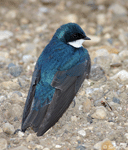 |
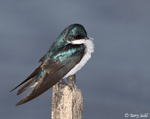 |
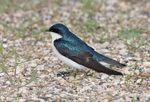 |
| Tree Swallow | Tree Swallow | Tree Swallow |
Birdhouses:
Will use specially made Purple Martin houses and gourds, as well as other birdhouses.
Feeders:
Breeding birds will attend for broken eggshells prior to nesting. As insectivores and birds that normally feed almost exclusively on the wing, feeding Purple Martins is problematic. During cold snaps when their normal prey is unavailable, some have reported success with mealworms or crickets, propelled into the air to stimulate a feeding response. Some Purple Martin house owners have "trained" birds to also begin accepting food items in a stationary setting, even placing mealworms or crickets in and around nesting boxes.
Conservation Status:
While possibly declining in many parts of its range, possibly due to competition with European Starlings and House Sparrows for suitable nest sites, Breeding Bird Survey records over the last 40+ years indicate relatively stable populations overall. The IUCN considers the Purple Martin to be a species of "least concern".
Further Information:
- USGS Patuxent Bird Identification InfoCenter, Purple Martin
- WhatBird - Purple Martin
- Audubon Guide - Purple Martin
Photo Information:
Photo taken on April 22nd, 2012 - Near Hartford, South Dakota - Terry Sohl
Audio File Credit:
- 1Phil Brown, XC433080. Accessible at www.xeno-canto.org/433080.
- 2Jim Holmes, XC317045. Accessible at www.xeno-canto.org/317045.
| Click on the map below for a higher-resolution view |
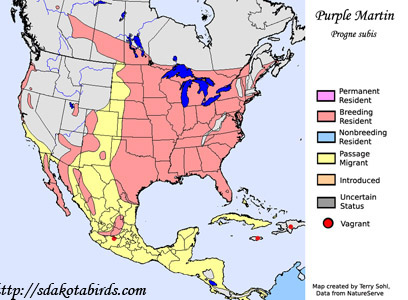 |
| South Dakota Status: Common summer resident in the northeastern part of the state. Uncommon elsewhere in the east, accidental in the far west. |
Additional Purple Martin Photos
Click for a higher-resolution version of these photos
